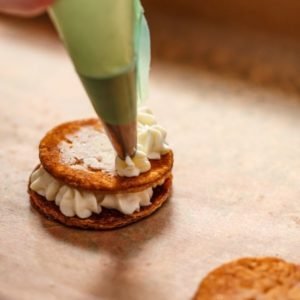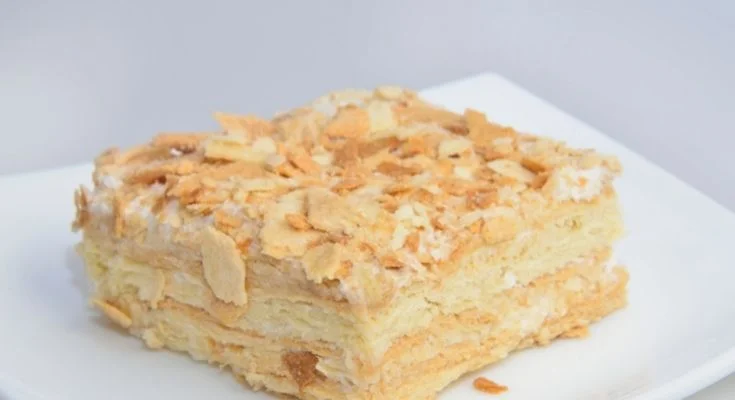A mille-feuille (pronounced “thousand-sheets” in French) A pastry comprised of puff pastry with pastry cream is called Napoleon, vanilla slice, or custard slice, among other names. Marie-Antoine Carême’s changes had an impact on its contemporary shape. A mille-feuille is typically composed of three layers of puff pastry (pâte feuilletée) and two layers of pastry cream (crème pâtissière), alternately. The top pastry layer may be decorated in a variety of ways, such as with whipped cream, icing sugar, chocolate, pastry crumbs, or sliced almonds. It can also be covered in fondant or icing alone, or in stripes of white and brown (chocolate) or another color of icing, alternated, and combed to provide a marbled appearance.

Mille Feuille Cake Recipe
Ingredients
For the Pastry and Filling:
- 1 1/2 pounds frozen puff pastry
- 3 cups store-bought pastry cream
- 2 tablespoons all-purpose flour
Instructions
Prepare the Pastry and Filling
- Gather the ingredients. Preheat oven to 400 F / 200 C.
- If using homemade puff pastry dough, have it ready and chilled. Or thaw store-bought frozen puff pastry dough according to the package directions.
- If you want to lighten the texture of the pastry cream, fold the optional whipped heavy cream into it. Cover and refrigerate until assembly time.
Bake the Pastry Layers
- On a lightly floured surface, gently roll out the puff pastry dough into an elongated rectangle, the thickness of a thin piece of cardboard.
- With a sharp knife, cut the dough into three equally sized pieces.
- Transfer the dough to a baking pan (or pans) lined with parchment paper and pierce the dough all over with a fork.
- Cover the dough with another sheet of parchment paper and place a baking pan or pie weights on top to weigh down the dough as it bakes.
- Bake the weighed-down dough, in batches if necessary, for about 18 to 20 minutes or until the dough is deep golden brown. The weights and the top layer of parchment paper pan can be removed for the last 5 minutes or so of baking to help crisp up the dough.
- Transfer the baked pastry layers to racks to cool completely.
Assemble the Mille-Feuille
- Gather the ingredients. If the baked pastry layers look unevenly sized, you'll have the chance to trim the edges for a uniform look after assembling the pastry.
- Start by distributing half of the pastry cream over one layer of baked puff pastry.
- Top with another layer of dough, pressing gently to adhere it to the pastry cream.
- Spread the remaining pastry cream over the second layer of pastry, top with the third layer of pastry, and again press down gently. Reserve.
Decorate the Mille-Feuille
- Melt the chocolate in a saucepan over very low heat and transfer it to a pastry bag or decorating tube fitted with a fine round tip. Alternatively, you can use a small plastic bag with a pierced or snipped corner to make a tiny opening. Reserve.
- Using a standing mixer or mixing by hand, make the royal icing by beating the egg whites, lemon juice, and confectioners' sugar on low until the mixture is very smooth and glossy. This should take at least 7 to 10 minutes.
- Add more confectioners' sugar or water, if necessary, to achieve a consistency so that when the icing is drizzled back into the bowl from the beaters, it will sit briefly on the surface of the icing before sinking back in.
- Immediately pour the royal icing over the top layer of the assembled pastry and spread it evenly over the entire surface with the help of a spatula. Some of the icing might drip over the edges.
- Working quickly before the icing sets, drizzle the chocolate across the icing in evenly spaced parallel lines. Don't worry if some of the chocolate drips over the edges or if your lines look sloppy. After trimming the edges the appearance will be very refined.
- Drag the tip of a thin, sharp knife through the lines of chocolate, spacing them evenly from one side of the pastry to the other; go first in one direction and then in the opposite direction to make a chevron pattern. This creates the most classic mille-feuille decorative pattern.
- Before trimming the edges or cutting into individual portions, refrigerate the assembled mille-feuille for at least two hours, or freeze for at least 30 minutes if pressed for time.
Serve the Mille-Feuille
- Once properly chilled, use a long, very sharp knife to cut 1/4 inch off the edges of the pastry all around to make a neat and evenly proportioned rectangle.
- Carefully transfer the trimmed mille-feuille to a serving dish and refrigerate again if not serving immediately, or cut into individual portions to serve. Enjoy.
Notes
- Total Fat 41g 52%
- Saturated Fat 9g 46%
- Cholesterol 60mg 20%
- Sodium 445mg 19%
- Total Carbohydrate 104g 38%
- Dietary Fiber 3g 11%
- Total Sugars 53g
- Protein 12g
- Vitamin C 1mg 4%
- Calcium 119mg 9%
- Iron 4mg 24%
- Potassium 276mg 6%
Final Thought:
Italian-speaking people refer to the traditional French pastry known as mille-feuille (pronounced meel-foy) as millfoglie. Both names refer to the cake’s numerous layers of puffy, buttery pastry, which give the appearance of “a thousand leaves.” The mille-feuille is a deliciously enticing combination of flavors and textures that is both heavy and light, flaky and creamy. It won’t be very sugary, but it will fulfill your sweet taste when having tea or coffee.
